词汇学 各章节教学目标
英语词汇学教学大纲(最新完整版)
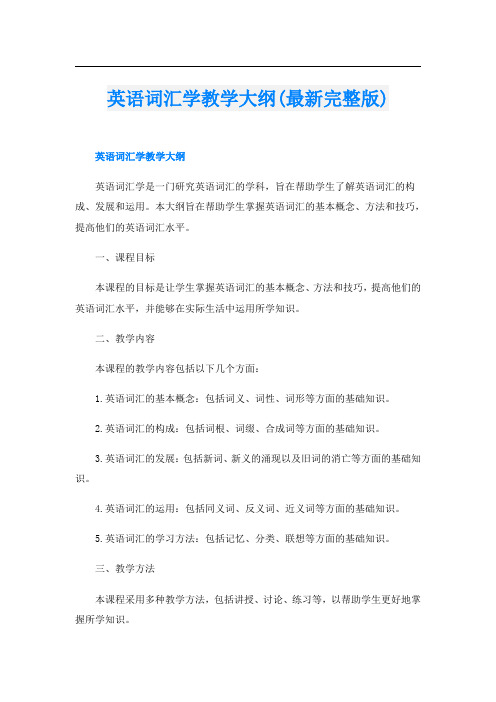
英语词汇学教学大纲(最新完整版)英语词汇学教学大纲英语词汇学是一门研究英语词汇的学科,旨在帮助学生了解英语词汇的构成、发展和运用。
本大纲旨在帮助学生掌握英语词汇的基本概念、方法和技巧,提高他们的英语词汇水平。
一、课程目标本课程的目标是让学生掌握英语词汇的基本概念、方法和技巧,提高他们的英语词汇水平,并能够在实际生活中运用所学知识。
二、教学内容本课程的教学内容包括以下几个方面:1.英语词汇的基本概念:包括词义、词性、词形等方面的基础知识。
2.英语词汇的构成:包括词根、词缀、合成词等方面的基础知识。
3.英语词汇的发展:包括新词、新义的涌现以及旧词的消亡等方面的基础知识。
4.英语词汇的运用:包括同义词、反义词、近义词等方面的基础知识。
5.英语词汇的学习方法:包括记忆、分类、联想等方面的基础知识。
三、教学方法本课程采用多种教学方法,包括讲授、讨论、练习等,以帮助学生更好地掌握所学知识。
四、考核方式本课程的考核方式为闭卷考试,包括选择题、填空题、翻译题和写作题等题型。
英语副词教学大纲模板____英语副词教学大纲________课程目标____:本课程的目标是让学生全面掌握英语副词的用法,理解它们在句子中的角色和影响,以及如何正确地使用副词来表达丰富、精确的情感和含义。
____课程主题____:1.副词的基本定义和用法2.副词的分类(时间、地点、程度、方式等)3.副词的比较级和最高级形式4.副词的运用语境5.副词的选用原则____课程结构和活动____:本课程将采用讲座、练习、案例分析和小组讨论等多种方式进行。
每周安排两次讲座,涵盖副词的不同主题;每天进行适量的练习,通过各种形式的活动让学生熟悉副词的用法;每两周进行一次案例分析,让学生在实际语境中理解和应用副词;最后,每一个月进行一次小组讨论,让学生分享学习心得和互相学习。
____评估和学习反馈____:课程的评估将通过学生的作业、练习和小组讨论的表现来进行。
《词汇学》课程英语专业教学大纲

《词汇学》课程英语专业教学大纲《词汇学》课程教学大纲一、课程说明:《词汇学》是英语翻译专业的一门选修课程。
该课程以现代语言学理论为指导,以英语词汇为研究对象,主要内容包括词汇基本知识、词汇的形态结构、词汇的构成方式、词汇的意义及语义关系、英语词汇的来源及发展、词义的变化、习语及词典知识等。
该课程有助于学生加强对英语词汇的认识,有助于翻译专业课程的学习。
从第四学期到第八学期,学生可根据具体情况在其中任一学期选修该课程。
二、教学目的及要求:该课程教学旨在使学生对英语词汇具有比较系统和完整的知识,深入地了解英语词汇的现状及其历史演变过程,并能对现代英语词汇发展所出现的现象作出分析和解释,提高词语的理解、释义和综合运用的能力,为学习翻译专业课程奠定词汇知识方面的基础。
三、教学重点及难点:英语词汇的发展过程和历史源源,有关英语词汇的基本理论、基本概念以及词的形态结构、构成方式、意义及语义关系、词意的变化、习语、词典知识等。
四、与其它课程的关系:该课程同其它语言学课程密切相关,均有助于学生从理论高度对英语语言有更加深入的认识,有助于翻译专业理论课程和技能课程的学习。
五、学时与学分:学时:36学时。
学分:2分。
六、教学内容:Chapter 1 A General Survey of English Vocabulary本章主要教学内容:1. Definition of language, linguistics, lexicology and words.2. Connection of Lexicology with Other Branches of Linguistics.3. Development of the English V ocabulary.4. Characteristics of the English Vocabulary Resulting from the Historical Development.5. The rapid growth of present-day English vocabulary and its causes.6. Classification of English words according to different criteria.本章教学目的及要求:通过本章的学习,使学生了解词和词汇的定义和区别,弄清词汇学与其它学科的联系,掌握词汇划分的基本原则及各类词的主要特点以及词汇的分类原则,领会基本词汇及本族语词在英语中的地位和重要性。
自考英语词汇学教案
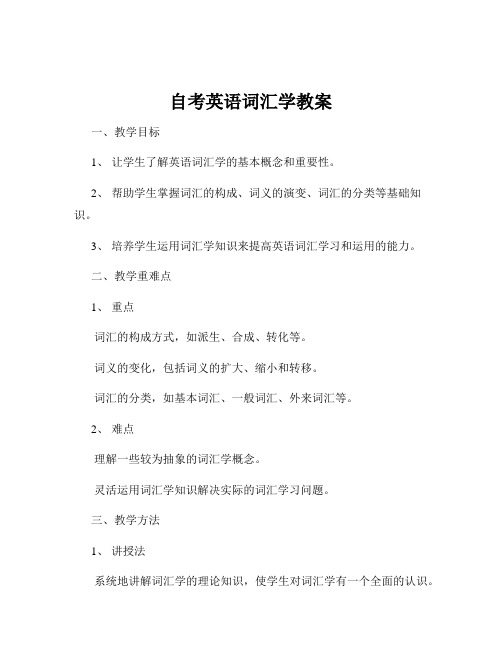
自考英语词汇学教案一、教学目标1、让学生了解英语词汇学的基本概念和重要性。
2、帮助学生掌握词汇的构成、词义的演变、词汇的分类等基础知识。
3、培养学生运用词汇学知识来提高英语词汇学习和运用的能力。
二、教学重难点1、重点词汇的构成方式,如派生、合成、转化等。
词义的变化,包括词义的扩大、缩小和转移。
词汇的分类,如基本词汇、一般词汇、外来词汇等。
2、难点理解一些较为抽象的词汇学概念。
灵活运用词汇学知识解决实际的词汇学习问题。
三、教学方法1、讲授法系统地讲解词汇学的理论知识,使学生对词汇学有一个全面的认识。
2、案例分析法通过实际的词汇例子,帮助学生理解词汇学的概念和规律。
3、练习法布置相关的练习题,让学生巩固所学的知识,提高应用能力。
四、教学过程1、导入(约 10 分钟)同学们,我先给大家讲个事儿。
有一次我去超市买东西,看到一个外国友人在挑选水果,他想要买苹果,但是不知道怎么说,就一直在比划。
旁边的售货员也很着急,不明白他到底想要什么。
最后还是我用英语跟他交流,解决了这个问题。
通过这件事,我就发现啊,掌握足够的英语词汇是多么重要。
而咱们这门英语词汇学,就是要帮助大家更好地理解和掌握英语词汇,让咱们在使用英语的时候更加得心应手。
2、知识讲解(约 40 分钟)(1)词汇学的基本概念解释什么是词汇学,以及它在英语学习中的地位和作用。
举例说明词汇学与日常生活、学习和工作的密切关系。
(2)词汇的构成详细讲解派生、合成、转化这三种主要的构词方式。
比如“unhappy”就是在“happy”前面加上“un”这个前缀构成的,意思就变成了“不开心的”;“classroom”是由“class”和“room”两个单词合成的,就是“教室”的意思;“water”这个词既可以作名词“水”,又可以作动词“浇水”,这就是转化。
(3)词义的演变介绍词义扩大、缩小和转移的概念和例子。
像“bird”这个词,原本指的是“幼鸟”,后来词义扩大,泛指“鸟”;“meat”过去指“食物”,现在词义缩小,只指“肉类”;“coach”最初是“马车”的意思,现在转移为“教练”。
英语词汇课教案
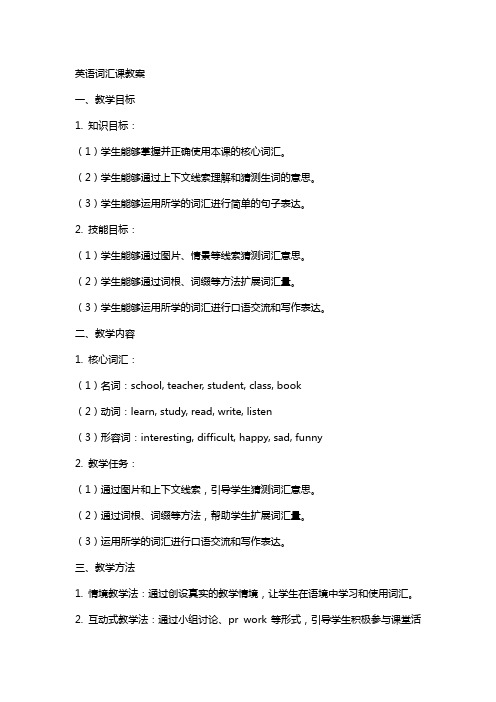
英语词汇课教案一、教学目标1. 知识目标:(1)学生能够掌握并正确使用本课的核心词汇。
(2)学生能够通过上下文线索理解和猜测生词的意思。
(3)学生能够运用所学的词汇进行简单的句子表达。
2. 技能目标:(1)学生能够通过图片、情景等线索猜测词汇意思。
(2)学生能够通过词根、词缀等方法扩展词汇量。
(3)学生能够运用所学的词汇进行口语交流和写作表达。
二、教学内容1. 核心词汇:(1)名词:school, teacher, student, class, book(2)动词:learn, study, read, write, listen(3)形容词:interesting, difficult, happy, sad, funny2. 教学任务:(1)通过图片和上下文线索,引导学生猜测词汇意思。
(2)通过词根、词缀等方法,帮助学生扩展词汇量。
(3)运用所学的词汇进行口语交流和写作表达。
三、教学方法1. 情境教学法:通过创设真实的教学情境,让学生在语境中学习和使用词汇。
2. 互动式教学法:通过小组讨论、pr work等形式,引导学生积极参与课堂活动,提高学生的口语表达能力。
3. 任务型教学法:通过完成具体的任务,让学生在实践中运用所学词汇。
四、教学步骤1. 导入:利用图片和实物,引导学生猜测词汇意思,激发学生的学习兴趣。
2. 呈现:通过上下文线索,呈现核心词汇,引导学生猜测意思。
3. 学习:通过词根、词缀等方法,帮助学生扩展词汇量。
4. 练习:通过口语练习和写作任务,让学生运用所学的词汇。
五、作业设计1. 口语作业:运用所学的词汇进行口语表达,录制短视频或进行角色扮演。
2. 写作作业:以所学的词汇为主题,编写一篇短文,展示对词汇的理解和运用。
3. 复习作业:制作词汇卡片,复习本课学习的词汇,加强记忆。
六、教学评估1. 形成性评估:在教学过程中,通过观察、记录学生的口头表达和写作练习,及时了解学生的学习情况,并根据学生的反馈调整教学策略。
词汇学教学大纲
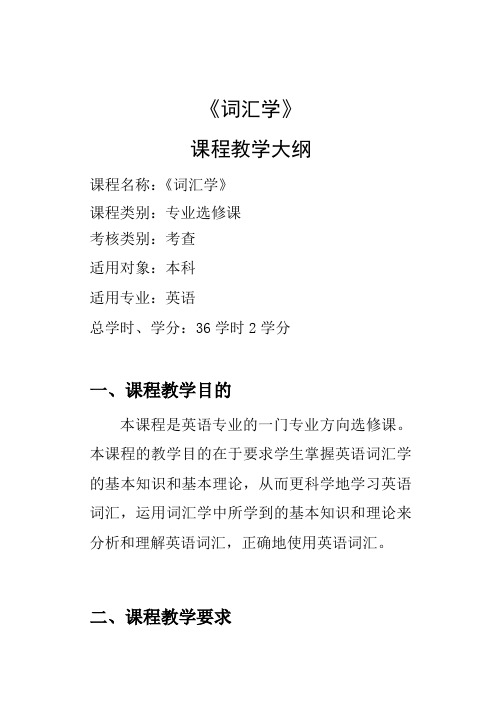
《词汇学》课程教学大纲课程名称:《词汇学》课程类别:专业选修课考核类别:考查适用对象:本科适用专业:英语总学时、学分:36学时2学分一、课程教学目的本课程是英语专业的一门专业方向选修课。
本课程的教学目的在于要求学生掌握英语词汇学的基本知识和基本理论,从而更科学地学习英语词汇,运用词汇学中所学到的基本知识和理论来分析和理解英语词汇,正确地使用英语词汇。
二、课程教学要求词的基本知识、英语的亲属关系与英语词汇的形成和发展、词的形态结构和构成方法、词的意义、语义关系、词义的演变、英语习语、英语词典等。
三、先修课程语音、语法、听力、口语等专业基础课程,基础英语等专业核心课程以及阅读等专业方向课程。
四、课程教学重、难点重点:词的基本知识;英语词汇的形成与发展;英语构词法;词义的演变;英语习语;难点:词的意义;语义关系和语义场。
五、课程教学方法(或手段)(一)教学手段1. 教师讲解,学生做笔记(采用多媒体教学);2. 学生自学、撰写学期或章节论文;3. 引导学生结合自己学习中碰到的问题进行讨论。
(二)教学方法采用教师为主导,学生为主题的教学模式,注重培养学生的系统思维能力和实际解决问题的能力,采用启发式、讨论式的教学方法,充分调动学生的积极性,发挥学生的能动性和创造性,并注重语言理论与实践结合起来,引导学生用理论解决学习中的实际问题。
教师布置阅读任务要求学生在课下阅读,然后在课上一起讨论,也可以在本课程网站上发帖讨论,或在线完成作业等。
六、课程教学内容第一章词汇学和词(2学时)一、教学内容(一)什么是词汇;(二)什么是词;(三)语言分析中的词;(四)词的类别;(五)词汇词和语法词;(六)词和语义场。
二、重、难点提示(一)重点:词的分类;词汇词和语法词;(二)难点:词的定义;词和语义场;基本词汇的特点。
第二章一些基本概念和词的意义(4学时)一、教学内容(一)语素,词位和语子;(二)词的意义;(三)七种意义;(四)词根和词干;(五)多义关系;(六)同音同形异义关系;二、重、难点提示(一)重点:词素;词素变体;(二)难点:词素的分类;词根和词干;多义关系;同音同形异义关系。
英语词汇学课程大纲
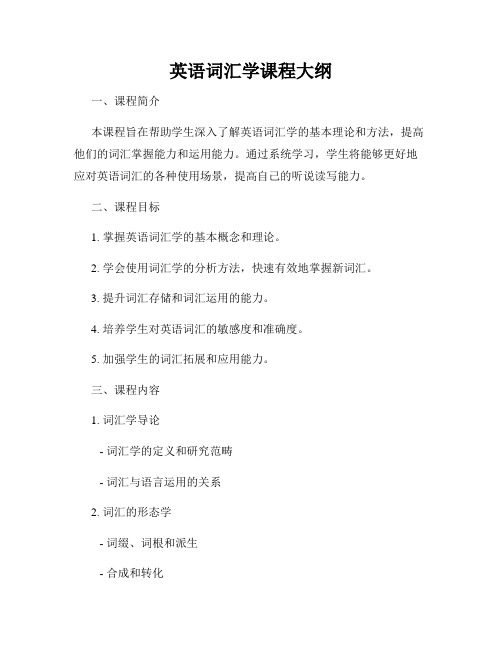
英语词汇学课程大纲一、课程简介本课程旨在帮助学生深入了解英语词汇学的基本理论和方法,提高他们的词汇掌握能力和运用能力。
通过系统学习,学生将能够更好地应对英语词汇的各种使用场景,提高自己的听说读写能力。
二、课程目标1. 掌握英语词汇学的基本概念和理论。
2. 学会使用词汇学的分析方法,快速有效地掌握新词汇。
3. 提升词汇存储和词汇运用的能力。
4. 培养学生对英语词汇的敏感度和准确度。
5. 加强学生的词汇拓展和应用能力。
三、课程内容1. 词汇学导论- 词汇学的定义和研究范畴- 词汇与语言运用的关系2. 词汇的形态学- 词缀、词根和派生- 合成和转化- 词类和词汇分类3. 词汇的语义学- 词义和词汇义项- 上下文词汇义变化- 词汇关系和语义网络4. 词汇的语用学- 语用角度解读词汇- 词汇的语用扩展和修辞手法5. 词汇学习策略- 词汇记忆和记忆技巧- 词汇学习中的输出训练- 词汇学习资源和工具的应用6. 词汇教学与评估- 词汇教学方法和技巧- 词汇教学的评估和反馈四、教学方法1. 理论授课:通过讲解和示范,向学生介绍英语词汇学的基本理论和相关知识。
2. 跟读练习:学生跟随老师的发音进行词汇的模仿和训练,提高语音和语调的准确性。
3. 词汇分析:通过案例分析和练习,学习如何分析词根、词缀和派生形式,快速掌握新词汇。
4. 语境运用:通过阅读和听力材料,让学生在真实语境中理解和运用词汇,增强语言综合能力。
五、评估方式1. 课堂讨论和问答2. 课后练习和作业3. 期中考试4. 期末考试六、参考教材1. 《英语词汇学导论》作者:张燕平2. 《英语词汇学教程》作者:郭建华3. 《英语词汇学教程》作者:赵玉华七、参考资料1. Aitchison, J. (2012). Words in the mind: An introduction to the mental lexicon. 4th Edition, Wiley-Blackwell.2. Nation, P. (2001). Learning vocabulary in another language. Cambridge: Cambridge University Press.以上为英语词汇学课程大纲,希望能够帮助学生在词汇学习中建立起系统的知识框架,提升词汇应用能力和学习效果。
英语词汇学大纲
《教学设计》教学大纲课程名称:英语词汇学(English Lexicology)课程代码:课程类别:专业课程学时:50学时学分:考核方式:考试适用对象:英语专业一、课程简介《英语词汇学》是英语专业本科生高年级阶段开设的一门专业任选课。
作为语言学的一门独立分支的实用学科,它已成为英语研究及英语教学的重要方面。
本课程主要是培养学生学习与英语词汇相关的基础理论,帮助学生系统掌握现代英语词汇的性质、构成和变化规律等方面知识, 比较深入地了解英语词汇的现状及其历史演变过程, 并能对现代英语词汇发展所出现的现象做出分析和解释, 从而不仅提高学生对词语的理解、释义和综合运用的能力,而且提高学生英语语言运用的整体水平。
二、教学基本要求通过本课程的学习,要求学习者:1.使学生了解词的来源、词的形态、词的构成方式、词的语义特征、各种词汇之间的相互关系和变化、词的联想与搭配等内容;2.了解英语词汇的形态结构和构词法规则有助于学生扩大自己的词汇量并自觉运用词汇;3.掌握词汇的历史发展和对词汇划分的原则将会使学生更深刻地理解词的意义,使他们能够有效地组织、划分和贮存词汇;4.认识词汇的语义结构、语义类型和语义关系会使学生增强对词汇意义和用法的了解,增强准确用词的能力。
三、教学重点及难点教学重点:1. 明确词汇学常用术语的定义;2. 词汇的语义结构、语义类型和语义关系并达到准确用词等等。
四、与其它课程的关系根据课程之间的衔接关系,英语词汇学课程的相关课程为《英语语言学》、《英语词源学》、《英语语义学》、《英语句法学》等专业基础课程,同时与后续的专业学习或实践紧密联系,是专业培养计划中承前启后的主干专业课。
五、教学内容Introduction (4学时)本章主要教学内容:Brief introduction of lexicology本章教学目的及要求:U nderstanding the definition of …lexicology‟Studying the relation between lexicology and other disciplines本章教学重点及难点:The relation between lexicology and other disciplinesChapter 1 Basic Concepts of Words and Vocabulary (4学时)本章主要教学内容:1.1 What is a word1.2 Sound and Meaning1.3 Sound and form1.4 Vocabulary1.5 Classification of words本章教学目的及要求:1. Understanding the definition of word2. Studying the relation between sound, form and meaning3. Mastering the different types of words本章教学重点及难点:1.The relation between sound, form and meaning2.Native words and borrowed wordsChapter 2 The Development of the English Vocabulary (4学时)本章主要教学内容:2.1 The Indo-European Language Family2.2 A historical overview of the English vocabulary2.3 Growth of present-day English vocabulary2.4 Modes of Vocabulary development本章教学目的及要求:1. Understanding the historical development of English2. Studying modes of vocabulary development本章教学重点及难点:The three historical periods of EnglishChapter 3 Word Formation I (4学时)本章主要教学内容:3.1 Morphemes3.2 Allomorphs3.3 Types of morphemes3.4 Root and stem本章教学目的及要求:1. Understanding the different morphemes2. Studying the difference between root and stem本章教学重点及难点:Different types of morphemesChapter 4 Word Formation(6学时)本章主要教学内容:4.1 Affixation4.2 Compounding4.3 Conversion4.4 Blending4.5 Clipping4.6 Acronymy4.7 Back-formation4.8 Words from proper names本章教学目的及要求:1. Understanding major types of word processes2. Studying some minor processes of word formation本章教学重点及难点:The major ways of forming wordsChapter 5 Word Meaning (4学时)本章主要教学内容:5.1 The meanings of “meaning”5.2 Motivation5.3 Types of meaning本章教学目的及要求:1. Understanding the difference between reference, concept and sense.2. Studying the different types of motivation本章教学重点及难点:1. The difference between reference, concept and sense.2. The different types of motivationChapter 6 Sense Relation and Semantic Field(6学时)本章主要教学内容:6.1 Polysemy6.2 Homonymy6.3 Synonymy6.4 Antonymy6.5 Hyponymy本章教学目的及要求:1. Understanding the definitions of sense relations2. Studying the classification of sense relations3. Mastering the use of sense relations本章教学重点及难点:1. The difference between polysemy and homonymy, form and meaning2. SynonymsChapter 7 Changes in Word Meaning (4学时)本章主要教学内容:7.1 Types of Change7.2 Causes of Changes本章教学目的及要求:1. Understanding the four types of changes2. Studying causes of changes本章教学重点及难点:The four types of changesChapter 8 Meaning and Context (4学时)本章主要教学内容:8.1 Types of Context8.2 The role of Context本章教学目的及要求:1. Understanding the two types of context2. Studying the role of context本章教学重点及难点:1. Linguistic context2. The role of context to eliminate ambiguityChapter 9 English Idioms (4学时)本章主要教学内容:9.1 Characteristics of idioms9.2 Classification of idioms9.3 Use of idioms本章教学目的及要求:1. Understanding the definition and classification of idiom.2. Studying the use of idioms本章教学重点及难点:The classification of idiomChapter 10 English Dictionaries (4学时)本章主要教学内容:10.1 Types of dictionaries10.2 Use of dictionaries10.3 Three good general dictionaries本章教学目的及要求:1. Understanding the different kinds of dictionaries.2. Studying the choice of dictionaries3. Mastering the different types of words本章教学重点及难点:1. the choice and use of dictionaries综合复习(2学时)六、教材及参考书1、教材:《英语词汇学》外语教学与研究出版社1999年2、教学参考书:Bauer, L. . Introducing Linguistic Morphology. Edinburgh: Edinburgh University Press.(1988)Bloomfield, L. . Language. Beijing: FLTRP.(2002)Foster, Brian . The Changing English Language. New Y ork: Penguin Books Ltd.(1971) Ginburg, E. S. et al . A Course in Modern English Lexicology. Moscow: Higher School Publishing.(1966)。
词汇学初中教案
词汇学初中教案课程目标:1. 让学生掌握词汇的基本概念和分类。
2. 培养学生正确运用词汇的能力。
3. 提高学生对英语词汇学习的兴趣和积极性。
教学内容:1. 词汇的基本概念2. 词汇的分类3. 词汇的运用教学重点:1. 词汇的基本概念和分类。
2. 词汇的运用技巧。
教学难点:1. 词汇的分类和运用。
教学准备:1. 教材:人教版初中英语教材。
2. 教学辅助材料:词汇卡片、PPT等。
教学过程:Step 1:导入(5分钟)1. 向学生引入词汇学的基本概念,让学生了解词汇在英语学习中的重要性。
2. 通过举例,让学生初步了解词汇的分类,如名词、动词、形容词等。
Step 2:词汇的基本概念(10分钟)1. 详细讲解词汇的基本概念,包括词汇的定义、特点和功能。
2. 引导学生通过举例来区分不同类型的词汇,如名词、动词、形容词等。
Step 3:词汇的分类(15分钟)1. 讲解词汇的分类,包括名词、动词、形容词、副词、介词等。
2. 通过PPT或词汇卡片,展示各类词汇的例词,让学生进行分类练习。
Step 4:词汇的运用(10分钟)1. 讲解词汇的运用技巧,如词汇的搭配、用法和词性转换等。
2. 引导学生通过造句或填空练习,运用所学词汇。
Step 5:课堂小结(5分钟)1. 让学生总结本节课所学的内容,巩固知识点。
2. 鼓励学生积极提问,解答学生的疑问。
Step 6:课后作业(课后自主完成)1. 让学生完成课后作业,巩固本节课所学内容。
2. 鼓励学生自主查阅词典,了解更多词汇知识。
教学反思:本节课通过讲解词汇的基本概念、分类和运用,使学生了解了词汇在英语学习中的重要性。
在教学过程中,要注意引导学生通过举例和实践来掌握词汇的分类和运用,提高学生的英语表达能力。
同时,要关注学生的学习反馈,及时调整教学方法和节奏,确保学生能够有效吸收和巩固所学知识。
英语词汇学教学大纲
《英语词汇学》课程教学大纲英文名称:Modern English Lexicology课程类型:专业课学时学分:32学时/2学分适用专业:英语一、课程性质、目的和任务该课程是英语专业高年级学生开设的专业基础课。
该课程的开设旨在使学生通过学习,了解英语词汇学的基本理论知识,并能用所学的知识去独立思考、分析问题和解决问题。
进而培养学生对语言研究的兴趣,为其在相关领域的进一步学习及研究打好基础。
二、教学基本要求该课程的学习以教师授课为主,学生自学为辅。
学生需在教师的指导下阅读有关词汇学书籍。
检查学生的阅读质量主要采取由学生复述阅读内容,并对阅读内容中的思想和观点做出个人的评价。
教师重点讲解学生在阅读中所遇到的重点和难点。
学生完成词汇学基础理论的学习后,应根据所学词汇学理论知识,在教师的指导下设计、完成自己的课程论文或参加考试。
三、课程内容1. 词的概述1.1词的定义1.2声音与意义1.3声音与拼写1.4词汇1.5词汇的分类2. 词的结构和词的构成方式2.1.词的组成单位2.2.实义形位、语法形位和形位变体3. 词的理据3.1拟声理据3.2语义理据3.3逻辑理据3.4词的理据的丧失3.5词的理据与文化历史的关系4.词的语义特征5. 词义的变化5.1一词多义5.2词义变化的方式6. 词的语义分类6.1词与词的上下义关系6.2词与词的同义关系6.3词与词的反义关系6.4词与词之间的同形或同音异义关系7. 词的联想与搭配7.1词的联想7.2词的搭配8. 英语习语8.1英语习语的特征8.2英语习语的分类8.3英语习语的整体与结构成分之间的关系8.4英语习语的修辞色彩和语体色彩8.5英语习语的应用9. 美国英语9.1国英语形成的历史概况9.2美国英语的特点9.3美国英语与英国英语的区别期末复习课1.教材:[1]《现代英语词汇学》.陆国强.上海外语教育出版社,2000年3月.六、说明1.修订大纲的指导思想本大纲制定的依据为英语专业教学指导委员会提出的高等学校英语专业本科英语词汇学课程教学的基本要求。
英语词汇学教学大纲
英语词汇学教学大纲一、引言在当今全球化的时代,英语已成为世界公认的国际交流语言。
而词汇作为语言的基础,对于学习英语和提高英语水平至关重要。
因此,本文旨在制定一份英语词汇学的教学大纲,以帮助学生全面掌握和应用英语词汇。
二、教学目标1. 掌握基础词汇量:通过词汇学习,学生能够熟练掌握5000个基础英语词汇,并能正确运用于口语和书面表达中。
2. 拓展词汇知识:学生能够逐步扩大词汇量,熟悉各个层次的英语词汇,包括常用词汇、学术词汇、专业词汇等。
3. 增强词汇运用能力:学生能够在实际交流和写作中灵活运用所学词汇,准确表达自己的思想和观点。
三、教学内容1. 基础词汇学习1.1 词汇分类:介绍英语词汇的不同分类,如名词、动词、形容词、副词等。
1.2 词根词缀:教授常用的英语词根和词缀,以帮助学生理解和记忆词汇的构成规则。
1.3 同义词和反义词:学习常见的同义词和反义词,提高学生的词汇选择能力。
1.4 词语搭配:介绍常用的词语搭配,帮助学生准确运用词汇。
1.5 词汇记忆技巧:引导学生使用有效的记忆方法,提高词汇记忆效果。
2. 拓展词汇学习2.1 学术词汇:介绍学术领域常用的英语词汇,如科学、文化、艺术等领域的专业术语。
2.2 专业词汇:针对不同专业的学生,提供相关专业词汇的学习和应用。
2.3 习语和惯用语:学习常见的习语和惯用语,使学生在语言表达中更具灵活性和地道性。
3. 词汇运用能力培养3.1 阅读训练:通过阅读文章、故事等材料,加深学生对词汇的理解和运用,提高阅读能力。
3.2 口语训练:开展口语练习活动,让学生在真实的交流中灵活运用所学词汇。
3.3 写作训练:引导学生进行书面表达,提高写作能力和词汇运用水平。
四、教学方法1. 多媒体教学法:利用多媒体设备和软件,播放生动有趣的词汇教学视频,激发学生的学习兴趣。
2. 互动教学法:通过小组讨论、问题解答等形式,增强学生的参与度和学习效果。
3. 逐步推进法:根据学生自身水平和进度,分阶段、循序渐进地进行词汇教学。
- 1、下载文档前请自行甄别文档内容的完整性,平台不提供额外的编辑、内容补充、找答案等附加服务。
- 2、"仅部分预览"的文档,不可在线预览部分如存在完整性等问题,可反馈申请退款(可完整预览的文档不适用该条件!)。
- 3、如文档侵犯您的权益,请联系客服反馈,我们会尽快为您处理(人工客服工作时间:9:00-18:30)。
2014-9Teaching objectives & difficulties in learning and teaching结合课程教学大纲(分为了解、理解、掌握三个要求)Chapter 1 A general survey of English vocabulary1.To understand and define “word” (many definitions);2.To know the historical development of English vocabulary and its rapid growth today;3.To summarize fundamental features of the basic stock of English vocabulary.Chapter 2 Morphological structure of English words1.To understand the ways that words are formed;2.To grasp the information about morpheme, allomorphs, and classification of morpheme.(Review knowledge of phoneme , e.g. assimilation辅音同化, 名词复数尾部读音规则等)Chapter 3 Word formation (I)1.To grasp 3 major processes of word formation(compounding, derivation/affixation,conversion);2.To explain, compare ROOT, STEM, BASE and can use them to analyse words;3.To learn with examples (share learning strategies).Chapter 4 Word formation (II)1.To grasp 8 minor processes of word formation (acronymy, clipping, blending, back-formation,words from proper names, neoclassical formation, miscellaneous);2.To conduct learning strategies by studying these process of word-formation(e acronymy, clipping, blending, back-formation in note-taking and dictation);3.To raise cultural awareness and to grasp comprehensive knowledge through examples ofthese 8 processes respectively(e.g words from proper names; esp. words from literature).Chapter 5 Word meaning and semantic features1.To discuss word meaning (conventionality and motivation);2.To discuss 2 main types of word meaning (grammatical and lexical), esp. lexical meaning(denotative meaning & associate meanings)3.To raise cultural awareness through associate meanings (connotative, social,stylistic,affectivemeaning) with typical examples;4.To discuss componential analysis and semantic features;to understand the practical usage of doing componential analysis.Chapter 6 Polysemy and homonymy1.To know the definition of polysemy (two approaches to polysemy & two processes leading topolysemy) and homonymy (types, sources);2.To discuss usage/stylistic value of polysemy and homonymy (e.g. making a pun).Chapter 7 Sense relations between words1.To look at the sense relations between words;(synonymy, antonymy, hyponymy)To consider word choice by making comparison and contrast;2.To discuss their usage;3.To grasp semantic field (e.g. ways of organising words into areas, collocations of words inthe same semantic field).Chapter 8 Meaning and context1.To understand polysemic words and homonyms better as the two are context-bound;2.To discuss types of contexts and the vital role of context in determination of word meaning;3.To learn suggested ways for correcting comprehension of word meaning;4.To learn vocabulary according to context/setting (e.g. authentic materials/exercises regardingto campus life).Chapter 9 Changes in word meaning1.To see how word meaning changes;2.To know causes of changes in meaning;3.To grasp 4 tendencies in semantic change;4.To discuss semantic development or change resulting from the figurative use of words(metaphor, metonymy);5.To summarise figurative uses of words (with a review of word phenomena in chapter 4, 5, 6,7 ).Chapter 10 English idioms1.To know the definition idioms;2.To notice characteristics of idioms;3.To appreciate and to conduct syntactic, structural and stylistic analysis of idioms(syntactic function, transformational restrictions, collocative restrictions, structurally variability, stylistic features).Chapter 11 American English1.To grasp the growth of American English3 periods (before independence, from independence to early 19th century, from the early 19thcentury to the present time);2.To discuss characteristics of American English;3.To compare differences between American English and British English(in spelling, pronunciation, grammar, vocabulary);4.To master certain accent (be it American English or British English) through the process oflearning; to train the ears to all accents.Notting Hill Elvios SHE songChapter 12 English dictionaries and how to use them1.To understand definition of lexicology and dictionaries,2.To know trends of English dictionaries;3.To have a knowledge of types of dictionaries (by varies criteria)and its main features;4.To learn the choice of a dictionary(e.g.,why monolingual dictionary, what are the criteria for choosing a dictionary (different purposes of learning);5.To discuss the advantages and different ways of using dictionary;esp. to grasp how to use a dictionary in the daily study, to read intro and guide to the use of the dictionary, to make full use of the entry contents, to choose the right meaning, to know the inadequacies of the dictionary;6.(up-to-date) To look at use of dictionary today, to discuss and think about the use ofdictionary (e-dictionary) in the future;7.(sum up for the whole course) To think and to practice what abilities a learner need todevelop in learning a word.。
